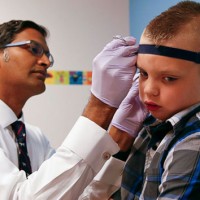
 Akron Children’s Hospital(AKRON, Ohio) — Elijah Bell often runs up to new people to show off his ears. The 8-year-old looks like any other kid with two ears and a big smile, except for the two box-like hearing aids placed just above his ears.
Akron Children’s Hospital(AKRON, Ohio) — Elijah Bell often runs up to new people to show off his ears. The 8-year-old looks like any other kid with two ears and a big smile, except for the two box-like hearing aids placed just above his ears.
“He loves them; he’s realty proud of them and shows his ears off to everyone,” Elijah’s mother, Colleen Bell, said. “It’s strange to people that he’s showing off his ears.”
She says the boy will then sometimes point out where the ears originated by pulling up his shirt to show two scars near his ribs. It’s the place where surgeons took cartilage to remake Elijah’s ears.
The boy was born without developed ears because of a genetic defect called bilateral artesia microtia. Elijah has been able to hear but, without developed ears to funnel and direct sound, needed hearing aids to transmit sound waves into his skull. He also required speech therapy to help him communicate fully.
“I think that over time, the way his ears [worked] and having little ears affected him,” Bell said of Elijah before his surgery.
He was less confident, she added.
Searching for a doctor who could help Elijah, Bell turned to Children’s Hospital in Akron, Ohio. It’s the same facility where Elijah was treated after being born prematurely. There, Elijah and his medical team, led by Dr. Ananth Murthy, the director of plastic surgery, started the long process of developing new ears.
Bell said Murthy and his team performed five surgeries in the past four years to create the ears for Elijah.
“He has battle wounds all over his body,” Bell said. “He had a skin graft taken from his upper thigh … he has [scars] where they harvested rib cartilage.”
In order to form the ears, cartilage was taken from Elijah’s rib cage and placed under skin along his hairline. As the tissue developed, the doctors were able to shape the ears by molding cutouts in the tissue.
“Elijah was born with bilateral artesia microtia, a very rare birth defect which affects about 1 in 50,000 people,” Murthy said in a statement. “By the time you are 6 to 8 years old, your ears are pretty much full grown. Doing the surgeries at that age allows these kids to start their school careers with normal ears.”
Copyright © 2015, ABC Radio. All rights reserved.















